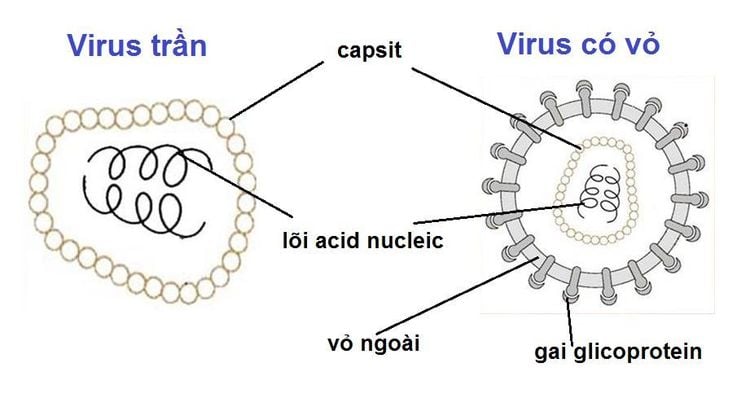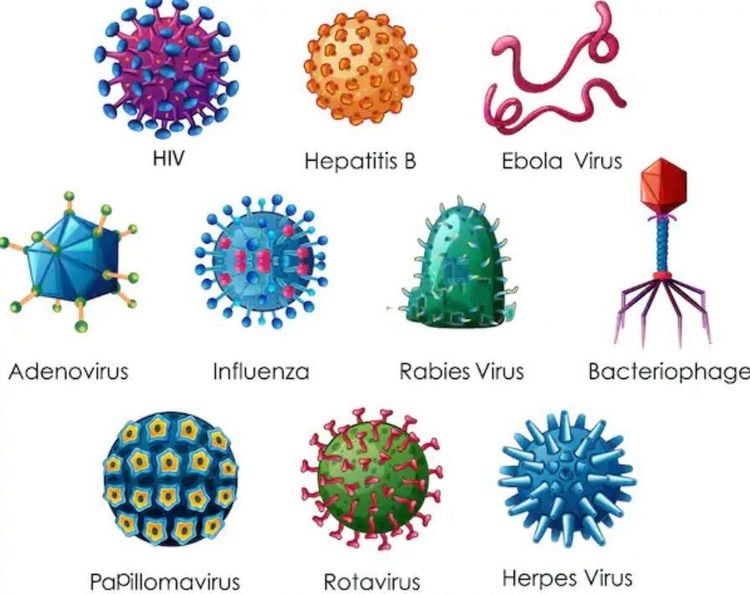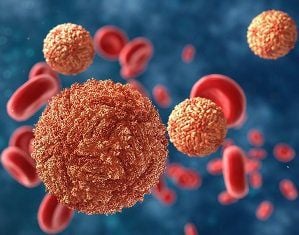This is an automatically translated article.
Posted by Master, Doctor Tran Thi Vuong - Laboratory Department - Vinmec Hai Phong International General Hospital
Virus is one of the infectious agents with very small size (diameter from 20-300mm), simple structure but the ability to cause disease to humans extremely quickly. Viruses have the basic properties of an organism, but they have no cellular structure, are unable to reproduce on their own, and have no metabolism.
1. Learn the structure of viruses
Viruses, also known as viruses, have structural features and replication patterns in host cells that are different from those of intracellular parasitic bacteria. A virus is considered structurally complete when it is capable of carrying out the transmission of nucleic acids from one cell to another. Each virus has only one of two types of genetic material, either RNA (ribonucleic acid) or DNA (deoxyribonucleic acid), no metabolic and respiratory enzymes, so they must parasitize in the receptor cells. other.The structure of the virus includes:
Trắc nghiệm: Bạn có phân biệt được chính xác cảm lạnh và cúm mùa?
Cảm cúm và cảm lạnh là hai khái niệm mà chúng ta thường đánh đồng nó giống nhau, không phân biệt rõ ràng. Dưới đây là một số câu hỏi trắc nghiệm, giúp bạn có thêm những kiến thức phân biệt cảm lạnh và cảm cúm. Từ đó, có những biện pháp điều trị bệnh phù hợp.1.1 General structure
Consists of two main parts, nucleic acids and capsid.Nucleic Acid- Genetic Material: Each virus has only one of two types of genetic material, either RNA or DNA. Nucleic acids play an important role such as: Carrying genetic information, specific to each virus, determining the ability of the virus to cause infection in the receptor cell, determining the replication cycle of the virus in the receptor cell and semi-antigen specific to viruses Capsid: It is the protein layer that covers the outside of the nucleic acid. These proteins have arrangements to form capsomeres. The capsid has the function of surrounding nucleic acids, protecting nucleic acids, they also participate in the attachment of viruses on the surface of receptor cells and carry virus-specific antigens -> applications in virus diagnosis, and at the same time keep the virus morphology and size stable.

1.2 Characteristic structure
The specific structure of a virus, also known as a special structure, is only present in certain viruses to perform specific functions for that virus and this is also the basis for identifying the virus.Virus with envelope and naked virus Virus has some specific enzymes
2. Virus classification
Viruses can be classified according to clinical symptoms, shape, route of transmission or structure of genetic material.
2.1 Classification according to the shape of the virus
In fact, each virus will have different physical characteristics such as filaments, spheres, complex cubes, rods, mace...
2.2 Classification according to the arrangement of capsid and nuleic acid
Viruses can be classified according to the arrangement of nuleic acid and capsid because viruses are divided into two types of symmetry: cubic symmetry and spiral symmetry. In the case of a virus with spiral symmetry, the nucleic acids and capsomers will be arranged along a regular or irregular spring, and in the case of cubic symmetry, the capsomers will be arranged in cubes polyhedral bridge.
2.3. Classification by symptomatology
This is the classical classification, which has the advantage of being clinically favorable but fundamentally virologically incorrect because in fact, a single virus is capable of causing many different diseases or a disease with can be caused by many different viruses:Virus that causes rash: Yellow fever, dengue hemorrhagic fever, smallpox virus, cowpox, measles, rubella ... Viruses that cause disease in the nervous system: Rabies virus, Eastern - Western equine encephalitis, Japanese encephalitis virus, measles virus, HIV virus, Herpes simplex virus... Viruses that cause eye disease: Newcastle, Herpes, Adeno virus... Liver disease virus: Virus causing hepatitis A, B, C, D, E... Viruses causing inflammation of the stomach and intestines: Norwalk, Rota virus... Genital viruses: HIV virus, papiloma virus, hepatitis B virus, Herpes virus... Viruses that cause respiratory diseases: influenza virus, respiratory syncytial virus, adenovirus... oral mucosa, type 2 causes mucosal disease genital tract, shingles virus causes dermatitis... Vinmec International General Hospital is one of the hospitals that not only ensures professional quality with a team of leading medical doctors, modern equipment and technology system. modern but also outstanding with comprehensive and professional medical examination, consultation and treatment services; civilized, polite, safe and sterile medical examination and treatment space.
Please dial HOTLINE for more information or register for an appointment HERE. Download MyVinmec app to make appointments faster and to manage your bookings easily.














